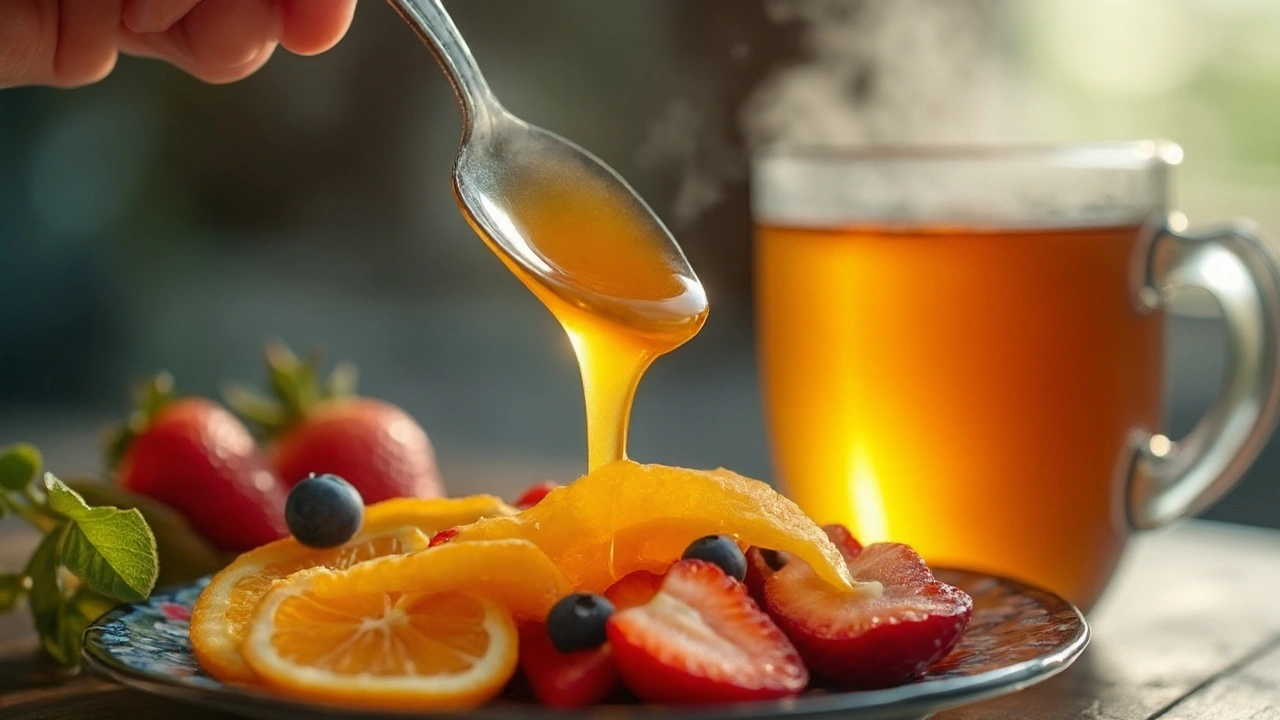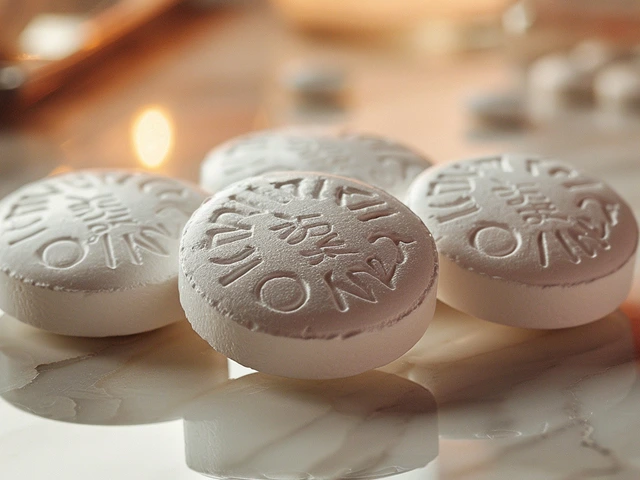Honey is a natural sweet substance produced by honeybees from flower nectars, renowned for its antibacterial and antioxidant properties. If you’ve ever wondered why a spoonful feels like a tiny health boost, you’re not alone. Modern research backs up centuries‑old folk wisdom: honey does more than please the palate. It can reinforce the immune system, soothe inflammation, and serve as a smarter sugar alternative. Below we unpack the science, compare it to other sweeteners, and give you real‑world tips to make the most of this sticky gold.
What’s Inside the Golden Nectar?
Honey isn’t just sugar. Its nutrient profile blends simple carbohydrates with a suite of bioactive compounds:
- Fructose (38%) and glucose (31%) - quick‑energy carbs.
- Minor sugars (maltose, sucrose) that add flavor depth.
- Vitamins B1, B2, B3, B5, B6, C and minerals such as calcium, iron, magnesium, and potassium, though in modest amounts.
- Polyphenols - flavonoids like quercetin and kaempferol, and phenolic acids such as caffeic acid.
Two Enzymes are especially pivotal. Glucose oxidase converts glucose into gluconic acid and hydrogen peroxide, creating an antimicrobial environment, while diastase (amylase) helps break down starches, supporting digestion.
These enzymes, together with the polyphenols, give honey its robust Antioxidants molecules that neutralize free radicals, reducing oxidative stress in cells.
Honey and the Immune System
The immune‑boosting reputation isn’t hype. Laboratory and clinical studies show honey can:
- Enhance phagocytosis - white blood cells more efficiently engulf bacteria.
- Modulate cytokine production, balancing pro‑ and anti‑inflammatory signals.
- Provide direct antimicrobial action through hydrogen peroxide and Propolis a resinous bee product rich in flavonoids and phenolic acids that fights bacteria, viruses, and fungi.
- Supply Bee pollen tiny granules packed with proteins, vitamins, and micronutrients that act as natural immunostimulants.
Collectively these components make honey a functional food that primes the Immune system the body’s defense network of cells and molecules that protect against pathogens.
Anti‑Inflammatory Power: From the Gut to the Whole Body
Chronic inflammation underlies many modern ailments - heart disease, arthritis, even mood disorders. Honey’s anti‑inflammatory actions operate on several fronts:
- Polyphenols scavenge reactive oxygen species, lowering oxidative damage that triggers inflammation.
- Hydrogen peroxide at low concentrations acts as a signaling molecule that can dampen excessive immune responses.
- Prebiotic fibers in honey feed beneficial gut bacteria, which produce short‑chain fatty acids that tighten intestinal barriers and reduce systemic inflammation.
Clinical trials report reduced C‑reactive protein (CRP) levels - a standard marker of inflammation - after daily honey consumption for 4‑6 weeks.
Honey vs. Other Sweeteners: Glycemic Impact and Health Trade‑offs
When you swap sugar for honey, the Glycemic index a scale measuring how quickly foods raise blood glucose drops from about 65 (table sugar) to 45‑55 for most raw honeys. The lower spike is due partly to fructose’s slower absorption and the presence of enzymes that modulate glucose release.
Compared to Table sugar refined sucrose composed of 50% glucose and 50% fructose, providing empty calories without micronutrients, honey offers:
- ~70% of the calories per teaspoon, so you can use slightly less.
- Additional vitamins, minerals, and antioxidants.
- Antimicrobial properties that can aid wound healing when applied topically.
Artificial sweeteners (aspartame, sucralose) score near zero on the glycemic index, but they lack honey’s bioactive cocktail and some users report gut‑flora disturbances. For most adults seeking a sweetener that also contributes nutrients, honey strikes a balanced compromise.

How to Use Honey for Maximum Benefit
Here’s a practical guide you can start today:
- Daily dose: 1-2 teaspoons (5-10g) of raw, unfiltered honey provides a meaningful antioxidant boost without overloading on sugars.
- Morning boost: Stir into warm (not boiling) water with lemon for a gentle immune‑supporting drink.
- Pre‑workout snack: Mix with oat‑based granola for quick carbs that spare muscle glycogen.
- Cooking tip: Use honey in marinades, sauces, or baked goods at temperatures below 140°C (284°F) to preserve enzymes.
- Topical care: Apply a thin layer to minor burns or cuts; the antimicrobial action can speed healing.
- Safety note: Avoid giving honey to infants under one year due to the risk of botulism. Those with severe pollen allergies should test a small amount first.
Quick Comparison of Common Sweeteners
| Sweetener | Glycemic Index | Antioxidant Content | Additional Nutrients | Antimicrobial |
|---|---|---|---|---|
| Honey (raw) | 45‑55 | High (flavonoids, phenolics) | Vitamins B, C, minerals, enzymes | Yes (hydrogen peroxide, propolis) |
| Table Sugar | 65 | Low | None | No |
| Artificial Sweetener (e.g., sucralose) | ~0 | None | None | No |
This table illustrates why honey earns a middle ground: lower glycemic impact than sugar, plus a suite of health‑promoting compounds absent from synthetic alternatives.
Related Concepts and Next Steps
Honey sits within a broader functional food landscape that includes items like kefir, turmeric, and green tea. If you enjoyed the deep dive into honey’s properties, you might explore:
- Prebiotic foods: How fibers from chicory root or Jerusalem artichoke support gut immunity.
- Bee‑derived supplements: The role of propolis tinctures and royal jelly in cardiovascular health.
- Seasonal diet strategies: Pairing honey with winter herbs (e.g., ginger, cinnamon) for extra anti‑viral defense.
Each of these topics builds on the same principles-leveraging natural bioactives to complement the body’s own defenses.
Frequently Asked Questions
Can honey raise blood sugar for diabetics?
Honey does contain sugars, but its lower glycemic index means it causes a slower, smaller rise in blood glucose than table sugar. Many studies suggest a modest daily amount (1‑2 teaspoons) is safe for type‑2 diabetics when incorporated into a balanced diet, though individual responses vary and medical advice is recommended.
Is raw honey better than processed honey?
Yes. Raw, unfiltered honey retains most of its enzymes, pollen, and propolis, which are often removed during high‑heat processing and fine filtration. Those bioactives are responsible for the antioxidant and antimicrobial benefits discussed earlier.
How much honey is safe to eat daily?
For most adults, 1‑2 teaspoons (5‑10g) per day provides health benefits without excessive calorie intake. People watching weight or sugar intake should stay at the lower end, while athletes may use slightly more for quick energy.
Can I use honey to soothe a sore throat?
Absolutely. A spoonful of warm honey (or honey mixed with lemon water) coats the throat, offers antimicrobial action against common pathogens, and reduces irritation. This is a time‑tested remedy backed by modern trials.
Is it okay to heat honey when cooking?
Heat above 140°C (284°F) deactivates vital enzymes like glucose oxidase, diminishing honey’s antibacterial and antioxidant potency. For most baking, keep temperature moderate or add honey after cooking to preserve its benefits.
Why shouldn’t infants under one year have honey?
Honey can contain Clostridium botulinum spores, which an infant’s immature gut cannot handle, leading to a rare but serious botulism. After the first year, the gut flora matures and the risk disappears.







17 Comments
This honey hype is so overdone. You think it's magic because it's 'natural'? Please. I've seen more bioactive compounds in a bag of sugar-free gummies. And don't get me started on 'raw honey' - if it's not pasteurized, it's just bee spit with a side of botulism risk. Stop romanticizing sticky goo.
While the article presents a compelling case for honey’s biochemical profile, the clinical evidence remains largely correlational. The antioxidant content, though quantifiable in vitro, does not necessarily translate to systemic bioavailability in humans. Moreover, the glycemic index comparison ignores insulin response variability across metabolic phenotypes. The assumption that honey is a 'healthier' sweetener presumes uniform physiological responses - a dangerous oversimplification.
I love honey on my toast in the morning. I use raw honey from a local beekeeper. It tastes better and I feel like I'm supporting something real. I don't know all the science but I know it makes me feel good. Just don't give it to babies. That part I get.
Honey is good but dont forget in India we use jaggery for centuries. It has same benefits and cheaper. Also honey is expensive and often adulterated. Why buy imported honey when local sweeteners work better? Science is fine but tradition matters too.
Let me ask you this - if honey is so full of antioxidants and enzymes, why hasn't Big Pharma patented it? Why is it still sold in jars next to the jam? Because the government and pharmaceutical industry don’t want you to know that a simple, natural substance can outperform their billion-dollar synthetic drugs. Propolis? Royal jelly? These are suppressed miracle compounds. They’ve been studied by the military. You think that’s a coincidence?
Wow, so now we’re supposed to believe American honey is better than European honey? I mean, come on. Our sugar industry is already pushing this stuff as a 'health food' to distract from the fact that we're the #1 sugar consumer on earth. And don’t even get me started on the bee colonies dying because of glyphosate - this article is just corporate greenwashing with a side of apiculture propaganda.
As someone who grew up in Singapore with honey-drizzled toast every Sunday, I can say this: honey feels like home. Not just because of taste, but because it’s tied to rituals - grandma’s cough remedy, temple offerings, even wedding sweets. Science explains the 'how', but culture explains the 'why'. I’m glad this article honors both. 🙏
Oh please honey is just liquid sugar with a fancy label. If you want antioxidants drink green tea or eat blueberries. And why is everyone acting like bees are little health wizards? They're insects. They don't care about your immune system. They just want to make more bees. This whole post is a scam to sell you expensive jars of sticky stuff.
For those new to functional foods, honey is a great entry point - but don't stop here. Pair it with fermented foods like kimchi or kefir to synergize prebiotic and probiotic effects. Also, consider tracking your blood glucose response with a CGM if you're metabolically sensitive. The key isn't just what you eat, but how your body responds. Small tweaks, big impact. You got this.
How dare you promote honey as healthy?! Have you seen how bees are treated in commercial apiaries? They're drugged, transported across continents, and their honey is stolen so humans can feel morally superior while eating it on their oatmeal. This is spiritual exploitation disguised as wellness. 🌿💔
I’ve been using honey for my dry cough for years and it’s always worked better than any medicine. I don’t need all the science to know what feels right. Just make sure it’s local and raw. And please, no one give it to babies. That’s just common sense.
STOP OVERCOMPlicating this! Honey is GOOD. It’s natural. It’s sweet. It’s healing. Use it. Eat it. Put it on your skin. Your body will thank you. No need to overthink it. Just get some raw honey and start today. You’re worth it. 💪🍯
The assertion that honey possesses superior antimicrobial properties compared to pharmaceutical-grade antiseptics is not supported by peer-reviewed clinical trials of sufficient rigor. While in vitro studies demonstrate inhibitory effects, the concentration-dependent bioavailability in human tissue remains unquantified. Furthermore, the variability in honey composition renders generalizations statistically invalid.
They don't want you to know that honey can cure cancer. They’ve buried the studies. The FDA banned research in the 80s because it threatened Big Pharma profits. I’ve seen testimonials from people who used raw honey instead of chemo - and lived. You think that’s coincidence? Wake up. This is about control. Honey is the truth they fear.
Is the bioactivity of honey an emergent property of co-evolved symbiosis between Apis mellifera and angiosperms - or merely a byproduct of ecological pressure? If we extract honey as a commodity, do we sever its epigenetic integrity? The question isn't whether honey works - but whether we’ve lost the context that made it meaningful.
Raw honey good but most honey sold is fake. Mix with corn syrup. Check the label. If its cheap its not real. I buy only from local farmer. Taste difference is huge. Also bees die for this. Be kind.
The article conflates correlation with causation. The observed reduction in CRP levels could be attributed to caloric restriction, placebo effect, or confounding dietary variables. The lack of randomized controlled trials with proper blinding renders the immune-modulatory claims speculative at best. Honey is not a therapeutic agent - it's a sweetener with minor ancillary benefits.
Write a comment